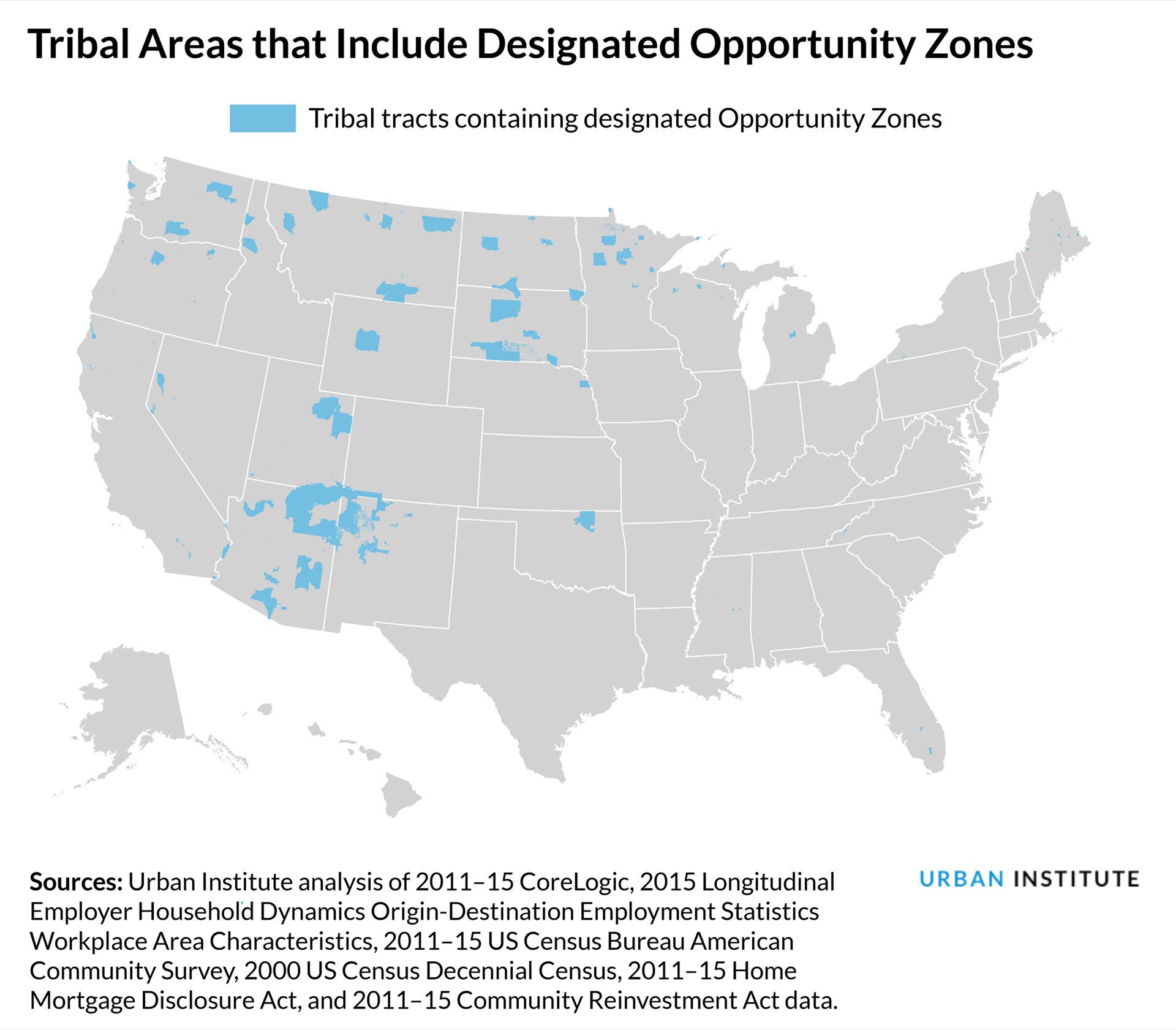
The Tax Cuts and Jobs Act of 2017 enacted some potentially potent investment tax incentives that are now available to investors in new property or businesses located in or near several hundred tribal jurisdictional areas throughout the United States. These new tax incentives are generally designed to promote economic development by attracting long-term capital into economically distressed communities.
The purpose of this post is to explore various steps that Indian Country leaders could take to better position a designated Opportunity Zone within or adjacent to the “reservation” or jurisdictional area of an Indian tribe (“Tribe”) for such private investment.
Generally, such steps include the following:
- Understanding how the Opportunity Zone tax incentives work in order to identify the type of investors who will be attracted to a potential Opportunity Zone investment.
- Identifying Opportunity Zone Funds with an interest in Indian Country investment opportunities, or (where appropriate) facilitating the formation of a new Opportunity Zone fund for a specific Indian Country investment.
- Conducting a realistic evaluation of the business prospects and profit potential for private investments in the Opportunity Zone in or adjacent to the Tribe’s territory.
- Making tribal governmental investments in infrastructure, as well as complementary business investments, that will make the tribal Opportunity Zone a more attractive business climate.
- Reviewing and updating the Tribe’s legal infrastructure (including tribal land leasing ordinances and regulations, secured transactions codes and other uniform commercial codes and model laws) to make its Opportunity Zone attractive to private investment.
Here are some preliminary thoughts on each of the above steps. Comments and additional insights are welcome.
Understanding How the Opportunity Zone Tax Incentives Work
Under the terms of the new statute, the new tax incentives are available to “taxpayers” (both individuals and taxable corporations) that have realized a taxable gain and are ready to reinvest the proceeds in an Opportunity Zone fund. The realized gain could be a result of any kind of investment—e.g., the sale of highly appreciated stock, or the sale of an interest in a business. The new Tax Code provisions make three specific benefits available to such taxpayers:
- Deferral of taxable gain on prior investment. This benefit allows taxpayers to temporarily defer recognizing a capital gain on their tax return if they invest the proceeds in an Opportunity Zone fund until they sell their interest in the fund, or until Dec. 31, 2026 (whichever comes first).
- Partial forgiveness of old gain. This benefit allows investing taxpayers to reduce the amount of deferred gain so long as they wait at least five years before selling the Opportunity Zone investment.
- No Tax on New Appreciation. If the taxpayers wait at least 10 years before selling their investment in the Opportunity Zone fund, the basis of their investment in the fund jumps to its fair market value when the fund is sold, meaning no additional gain resulting from the appreciation in the fund’s value will have to be recognized.
Based on the above, one can easily conclude that prospective Opportunity Zone investors will be individuals or corporations that have previously made very profitable investments that for one reason or another they are inclined to sell, but do not want to immediately recognize gain. It is also fair to conclude that such prospective investors generally will be looking for long-term investments (not quick turn-arounds) to maximize their tax benefits.
Some investors who fit this profile might also have philanthropic goals, including a commitment to making socially responsible investments. For example, instead of gifting highly appreciated stock to a foundation or other charity, a socially responsible investor might find it attractive to sell the stock and invest the proceeds in an Opportunity Zone fund—particularly one that promises to make investments to improve marginalized communities, such as exist throughout Indian Country and rural America. Tribes may want to work with charitable foundations and Native philanthropic organizations to identify and cultivate such investors.
Identifying Opportunity Zone Funds with a Focus on Indian Country Investments
As of the date of this blog post (September 19, 2018), I am not aware of any Opportunity Zone Funds in formation that have a specific focus on Indian Country investments1. It is likely that such funds will emerge in the coming months once tribal leaders and investors collaborate, and the process for Opportunity Zone fund formation becomes more well defined. Currently, the process is described only briefly on an IRS website devoted to Opportunity Zone “Frequently Asked Questions.”2
In addition to identifying any Indian Country-focused Opportunity Zone funds, tribal leaders looking to stimulate Opportunity Zone investments should also consider collaborating with prospective investors to form a special purpose Opportunity Zone Fund. Such special purpose funds are already being formed for other Opportunity Zone investment projects. Although IRS has not yet released the tax form for reporting the Opportunity Zone Fund formations, there is no reason why such funds cannot be formed now so long as the general statutory requirements are met.3
Notably, the statute requires that Opportunity Zone Funds be organized as a corporation or partnership. Although it would not make sense for a tax-exempt tribe to take a substantial ownership position in Opportunity Zone Fund, there is nothing to prevent a tribe or tribal organization from holding a small ownership interest in an Opportunity Zone Fund or from serving as a manager of such a fund.
Evaluating Business Prospects in an Opportunity Zone
Once a Tribe has confirmed that an Opportunity Zone includes a tribal jurisdictional area, it may want to conduct its own evaluation of the prospects for specific types of business investment in the zone. In recognition of the fact that investment will be driven by market forces (and not government mandates), tribes and other governments should work to present the case for why business investment in a specific location is likely to be successful and to address any perceived limitations, such as availability of a ready work-force. Some of these efforts may need to be done in collaboration with local or state governments—particularly if the Opportunity Zone includes both tribal and non-tribal land. Some municipal governments are already hosting business forums aimed at highlighting the potential projects within designated Opportunity Zones.
Under the Opportunity Zone legislation, there are very few legal limitations on the types of investments that can be made by an Opportunity Zone Fund. However, the statute does provide—by cross-referencing Section 144(c)(6)(B) of the Code--that investments in a golf course, massage parlor, hot tub facility, suntan facility , racetrack or other gambling facility, or a liquor store --do not qualify. Therefore, tribes should identify which businesses are needed (e.g., market demand for a grocery store or affordable rental housing) and be prepared to show potential investors how investment in such a business could be successful over a five to ten-year period.
Tribal Investments in Infrastructure and Complementary Businesses
While a tribal government is not a taxpayer eligible for the Opportunity Zone tax incentives, appropriate tribal investments within a tribal Opportunity Zone could materially increase the likelihood of attracting private investors eligible to make investments in such an Opportunity Zone. Appropriate infrastructure investments might include:
- Road work
- Site preparation and grading
- Utility improvements
- Water/sewer upgrades
Complementary businesses that a tribe might invest in to attract additional private investment could include the establishment of certain types of public entertainment venues, housing and public accommodations, and gas stations and convenience stores. Tribal casinos that have already become destination resorts will be in a good position to attract private investment—and the designation of nearby areas as Opportunity Zones will enhance their attractiveness to investors if the tribe is seeking such investment.
Reviewing and Updating Tribal Legal Infrastructure to Attract Private Investment
A final critical step in preparing for Opportunity Zone Fund investments in an Opportunity Zone within a tribal jurisdictional area is the review and updating of tribal legal infrastructure relevant to private investment, lending and leasing. Private investors will be most comfortable investing in a tribal Opportunity Zone if the host Tribe has adopted secured transaction and other commercial codes that are comparable to state codes.4 This can easily be done by using model codes. Tribes should also look at whether their leasing authority has been updated and streamlined to avoid excessively time-consuming BIA regulation and approval processes. Tribes that have HEARTH Act leasing ordinances in place will have any easier time attracting private investment to trust land where investors will need to execute land leases to establish an Opportunity Zone business.
For more information about any of the topics discussed above, please contact the author at Kathleen.nilles@gmail.com. Kathleen Nilles is a tax attorney who recently retired from the practice of law. Previously, she was a partner with the law firm of Holland & Knight LLP and a member of its Native American Law Group.
Opportunity Zone Background
Under the legislative scheme enacted by Congress, each state’s Governor was given broad latitude in designating qualifying zones, and state officials were not required to consult with tribal or local government officials in making their selections—although some did so. The statute required nominated zones to qualify as Low-Income Community (“LIC”) census tracts. Governors could also nominate a small number of tracts (up to 5% of their total nominations) that were merely contiguous to a LIC census tract. The IRS explained the nomination and designation procedure in a Revenue Procedure issued in February 2018. See Rev. Proc. 2018-16: Procedure for Designating Census Tracts as Qualified Opportunity Zones for Purposes of §§ 1400Z-1 and 1400Z-2 of the Internal Revenue Code. Each governor could nominate a minimum of 25 zones, and up to 25% of the eligible LIC census tracts in the state.
The nomination and designation process is now complete, and the IRS has issued a list of the designated zones by state and census tract number. See IRS Notice 2018-48: Designated Qualified Opportunity Zones under Internal Revenue Code 1400Z-2 (June 20, 2018). In addition, the Department of Treasury’s CDFI Fund has provided an interactive map which allows a comparison of where the new Opportunity Zones are located relative to Indian tribal jurisdictional areas.
Although it is difficult to identify all the tribal areas that were selected, commentators familiar with these resources have suggested that as many as 400 census tracts located within (or contiguous to) tribal jurisdictional areas have been designated as Opportunity Zones. See, e.g., Nancy Pindus and Brady Meixell, “Why Opportunity Zones are Important for Indian Country,” (June 7, 2018). Other commentators have estimated the number of tribal areas designated as Opoportunity Zones as being closer to 300 zones. See “Opportunity Zone: The Map Comes into Focus." Based on these numbers, Opportunity Zone designations represent a substantial opportunity for a significant cross-section of Indian Country.
However, as the commentators have also noted, there is no government action that will ensure that any amount of private capital flows to a tribal (or non-tribal) Opportunity Zone. Instead, investments will be guided by market forces as perceived by the tax-motivated investors. And the tax benefits will be most attractive to investors who are inclined to cash out of highly appreciated investments and who believe that available new investments in Opportunity Zones have potential for long-term appreciation in value.
The author recognizes that the legislation failed to mandate and provide adequate lead time for state-tribal consultation in the Opportunity Zone designation process, and that there remain many concerns about whether the federal tax subsidies will be wisely utilized in a program that is neither highly regulated by government agencies nor readily transparent to public scrutiny.
Endnotes
1 By contrast, the New Markets Tax Credit and related federal loan programs spawned many Native Community Development Financial Institutions (Native CDFIs) that sought to direct investor capital into Indian Country. For a partial list of these CDFIs, see Members of the Native CDFI Network. According to the website of First Nations Oweesta Corporation, one of the first Native CDFIs to be certified by the Treasury Department, there are currently over 70 Native CDFIs and over 40 of these CDFIs are members of the Native CDFI Network. See www.oweesta.org.
2 See Internal Revenue Service, Opportunity Zones Frequently Asked Questions (last updated on June 7, 2018).
3 For a good summary of those requirements, see Tax Reform's New Incentives for Investments in Low-Income Communities: Part 2.
4 See e.g., the 2017 Revised Model Tribal Secured Transaction Act and other legal infrastructure resources at https://www.minneapolisfed.org/indiancountry/resources/tribal-legal-infrastructure.
* The CDFI Fund at the U.S. Treasury also created a map of all Indian Country Opportunity Zones depicting the designated tracts within tribal jurisdictions (zoom in to see designated tracts overlaid on reservation boundaries). U.S. Treasury CDFI Fund (July 2018).





